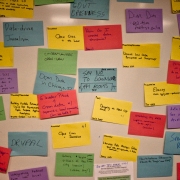How to weight and organize evidence
In a typical financial white paper, you must organize evidence to support your argument. John R. Trimble’s Writing with Style suggests how you can do that.
Step 1. List the evidence
In Trimble’s example, a writer starts by listing all of the evidence. Next, the writer weighs the arguments. This is important because “the shotgun approach—a blast of unconnected reasons—is out of the question,” says Trimble.
Step 2. Categorize
Next, it’s time to organize the arguments by category. “This is a crucial part of the writing process, he knows, for his reader will expect the proof of this is sorted into neat, logically developing stages.” In Trimble’s example, the evidence is divided into moral, economic, political, and legal reasons.
Categorizing is a step that lends itself to mind mapping, a technique that I discuss extensively in Financial Blogging: How to Write Powerful Posts That Attract Clients. With Trimble’s example, I’d create “branches” for moral, economic, political, and legal reasons around a central circle holding the paper’s topic. That mind map would give me a bird’s eye perspective, which would help me work on Trimble’s next task.
Step 3. Put in the right order
Figuring out the sequence for presenting the arguments is an important related task. This poses questions, says Trimble:
Should the most persuasive ones all come first, or should he build his argument from least persuasive to most persuasive, or should he mix them? Or would he be wiser to eliminate most of the marginally persuasive reasons and go for quality rather than quantity?
Trimble votes for quality over quantity. I agree.
However, he also votes for an “increasingly persuasive order of arguments.” That’s often not the best approach, in my opinion, especially if the arguments are discrete, and don’t build on one another. In that case, you might lose your readers before they reach your best arguments.
My take on the right order
I’d prefer to start with the strongest argument. That helps you to capture your readers’ attention so they’ll stick with you throughout your white paper.
With the evidence in Trimble’s example, I might start with the strongest category and the strongest point within that category, and then move through the weaker points in that category. Then, I’d move on to the second-strongest category.
Of course, starting with the strongest category’s strongest point isn’t always possible. Sometimes that strongest point rests on a weaker point in that category—or in a different category. Such complex relationships are why I enjoy mind mapping to help me visualize the relationships among the points I want to make.
Whether or not you agree with every detail of Trimble’s approach, he’s right that you must categorize and weight the evidence to persuade your readers.
Disclosure: If you click on an Amazon link in this post and then buy something, I will receive a small commission. I provide links to books only when I believe they have value for my readers.
The image in the upper left is courtesy of Tony Webster [CC BY-SA 3.0]




